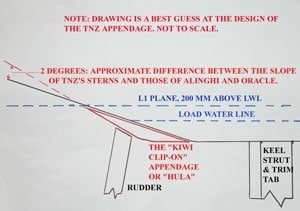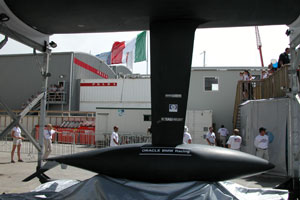
The three teams remaining in the 2003 America’s Cup have shown that good minds don’t always think alike. At the unveilings for the Louis Vuitton Challenger Final on Jan. 7, Alinghi Challenge, Oracle/BMW Racing, and Team New Zealand revealed different ways to address the America’s Cup Class design space.
Four yachts were unveiled–SUI-64, USA-76, NZL-81 and NZL-82. These yachts are now in a “no change” period, requiring them to maintain their declared, certified condition until the end of the Louis Vuitton Final, although not later than Jan. 19 for Team New Zealand.
Here are some of the yachts notable features.
HULLS
Profile All of the yachts have similar enough underbody profiles through their mid-length, but not in their double-knuckle bows. Alinghi and the two Team New Zealand (TNZ) yachts have bow profile slopes very much like the winning NZL-60 in 2000. Oracle’s is significantly different, however, with a shallower slope and correspondingly softer lower knuckle. Afterbody profiles have distinguishable differences in the transition from the flattish, mid-length rocker to the straight run up through the counter, or after overhang. Alinghi has the fairest form through this region. Oracle and TNZ each have more distinct, local curvature just before the rise to the counter. However, there is more to tell about TNZ’s hula in this area, to follow.
Beam All four yachts are narrower than the norm in 2000. NZL-82 appears to be more than 200 mm narrower than NZL-60, and Alinghi appears to be a little narrower again. The three yachts shown by these two teams have vertical topsides at maximum beam. Oracle is noticeably more extreme in this regard. The maximum beam seems to be dictated by the sheeting requirements of the genoa. There is pronounced flare below this, resulting in a substantially narrower waterline beam than the other yachts.
Sections All but one of the yachts have some degree of flattened U-sectional shape amidships. NZL-81 has a round midship section shape, instead. They are all round under the forefoot, while the sections aft develop aft into broad, flat counters.
Sheerline The class rule prescribes minimum freeboard limits forward, midships and aft. However, there is latitude in the sweep of the sheer through those points. Both challenge yachts have kept the sheerline low along the foredeck and swept it up abruptly toward the stem. TNZ’s yachts carry a fair sheerline to a lower stem head.
HULA
TNZ has developed a large, hull appendage, code-named “hula,” exploiting the class rule such that effective sailing length is increased. The rule prohibits hollows in the surface of the hull, except near the centerline in association with an appendage. Both TNZ hulls have been designed with a flat surface that intersects the afterbody, slicing a portion of the hull from the fair, overall shape. The surfboard-like slice is then attached to the structural hull as an appendage. This permits hollows to exist between the lines of the appendage and the lines of the hull, dodging the prohibition against hollows in the hull. The “hula” is attached below the height of the after girth station–used to determine rated length–within the permitted 500 mm wide region of allowed hollows. To satisfy the rule, the hula must not touch the hull outboard of this strip, so a thin gap must be maintained, even under extreme hydrodynamic loading.
The hula revealed by TNZ has only a small inflection of the profile in way of the after girth station, which is located 200 mm above the measurement waterline. It is an essentially fair continuation of the hull surface otherwise. The resulting hull/hula shape forward of the girth station on NZL-81 and NZL-82 is much like any other Americas Cup Class hull. Aft of the girth station, however, the counter profile can be rotated about 2 to 3 degrees shallower, or down toward the water. For that benefit, there is a drag penalty at all times due to the gap separating the hula from the hull, as well as a stability loss by reduced bulb weight corresponding to the hulas weight.
The considerable curiosity provoked by TNZs hula has been partially satisfied by the unveiling. While radical in practical concept, what TNZ revealed at the unveiling does not reflect a significant change to the overall lines of the yacht. However, keep in mind that this hula only needs to satisfy a public viewing requirement. The clever Kiwis just might have a more provocative, private dancer hidden away until the Match unveiling on Feb. 11.
|
|
| |
|

|
| |
| Stuart Streuli|
| |
|
|
| |
| The Oracle bulb is the shortest and fattest of the four bulbs. It’s also the only one with the winglets mounted on the aft end.* * *|
| |
|
|
|
KEELS
Bulbs The four yachts have four different bulbs. Alinghi’s is a squashed, cigar shape, much like NZL-60’s in 2000. Oracle’s is a refined variant, a little shorter and thicker than Alinghi’s, but with a fine entry, hollowed lines flowing back to the beavertail and a sculpted “dillet,” or Coke-bottle type hollowing, where the fin intersects the top of the bulb. NZL-81’s bulb appears a little longer and more slender than Alinghi’s, and NZL-82’s is radically long and slender, perhaps more than 2 meters longer than the typical length of approximately 5 meters. The mid-length region of both of TNZ’s bulbs have a flat bottom out to a corner to which the winglets are attached.
Longer, more slender bulbs have greater wetted surface drag than short bulbs of equal volume, while shorter, fatter bulbs have greater form drag. It is evident that the experts designing these fourth-generation Americas Cup Class yachts havent exhausted their search for the ultimate bulb design trade-offs.
Winglets Three teams have three solutions for winglet location. Oracle, alone, has tail-mounted winglets, angling downward to maximum draft from the beavertail. Alinghi’s winglets are located just aft of the keel fin, angled down from the bulb’s maximum diameter. TNZ’s are also mid-mounted, almost directly under the trim tab, but extending horizontally from the bottom, outer edge of the bulb. Winglet spans among all four yachts appear reasonably similar.
Keel Fins Again, there are four schools of thought. Alinghi’s keel fin has the greatest chord length, and, hence, area, together with the greatest amount of trim tab. The fin has almost no taper. Oracle has a moderate-area fin having significant taper and a substantial strake under the hull, extending forward of the keel root. NZL-81 fin is also moderate in area, while NZL-82’s is significantly shorter in chord length.
RUDDERS
Alinghi has the deepest rudder, extending to just above the flow lines of the bulbs trailing vortex. Its quite short in chord length and modest in area. Oracles rudder is also quite deep while being longer in chord length than Alinghis–evident in Oracles deft maneuvering. Both of TNZs yachts have shallower rudders than the challengers, with moderate area and somewhat different profiles to one another.
RIGS
In 2000, Team New Zealand introduced the “Millennium Rig,” consisting of double diagonal stays in an X pattern. A feature at the time was a three-spreader configuration, while the conventionally stayed rigs of the challengers had four sets of spreaders. This time, all yachts have the X-rig, but the spreader count is the other way around. The challengers have three-spreader X-rigs, while TNZs rigs have four sets. All rigs have jumper struts that have evolved into topmast spreaders, aligned essentially athwartships. Conspicuous on all of the rigs are “bat-wing” upper spreaders. They have significant chord length and extensions aft that squeeze out a little extra jib trim and clean up the airflow from the jib onto the mainsail.
The vertical shrouds on the TNZ yachts use two rods close together. Because streamlined rigging is not allowed, two, smaller, fore-and-aft rods result in a more streamlined configuration than the single, larger rod that they replace. Its clever, but defeats the cost-saving intent of prohibiting streamlined rigging.
Both Alinghi and TNZ have placed their masts several diameters forward of the keel fin. Oracles mast is stepped closer to the keel fin. The more forward placement of the rig on Alinghi and TNZ suggests perhaps greater loading of their mainsails than on Oracle.
Not as evident is the internal mechanical engineering that has gone into tuning controls of the respective rigs. All of the teams have expended considerable time and resources to extract the maximum power out of their sails over the widest range of conditions. The sails themselves, the spars and stays that shape them, and the crews who know how to control them best will likely be more important to winning the Louis Vuitton and Americas Cups than the platforms that carry them.
David Pedrick’s experience as an America’s Cup yacht designer began with the 1974 Cup winner Courageous while at Sparkman & Stephens and includes the 1987 winner _Stars & Stripes. He helped create the current America’s Cup Class rule in 1988 and recently completed six years as chairman of the International Technical Committee for the IMS handicapping system. His Newport, R.I., firm also designs a wide range of cruising yachts, from classics to superyachts._









